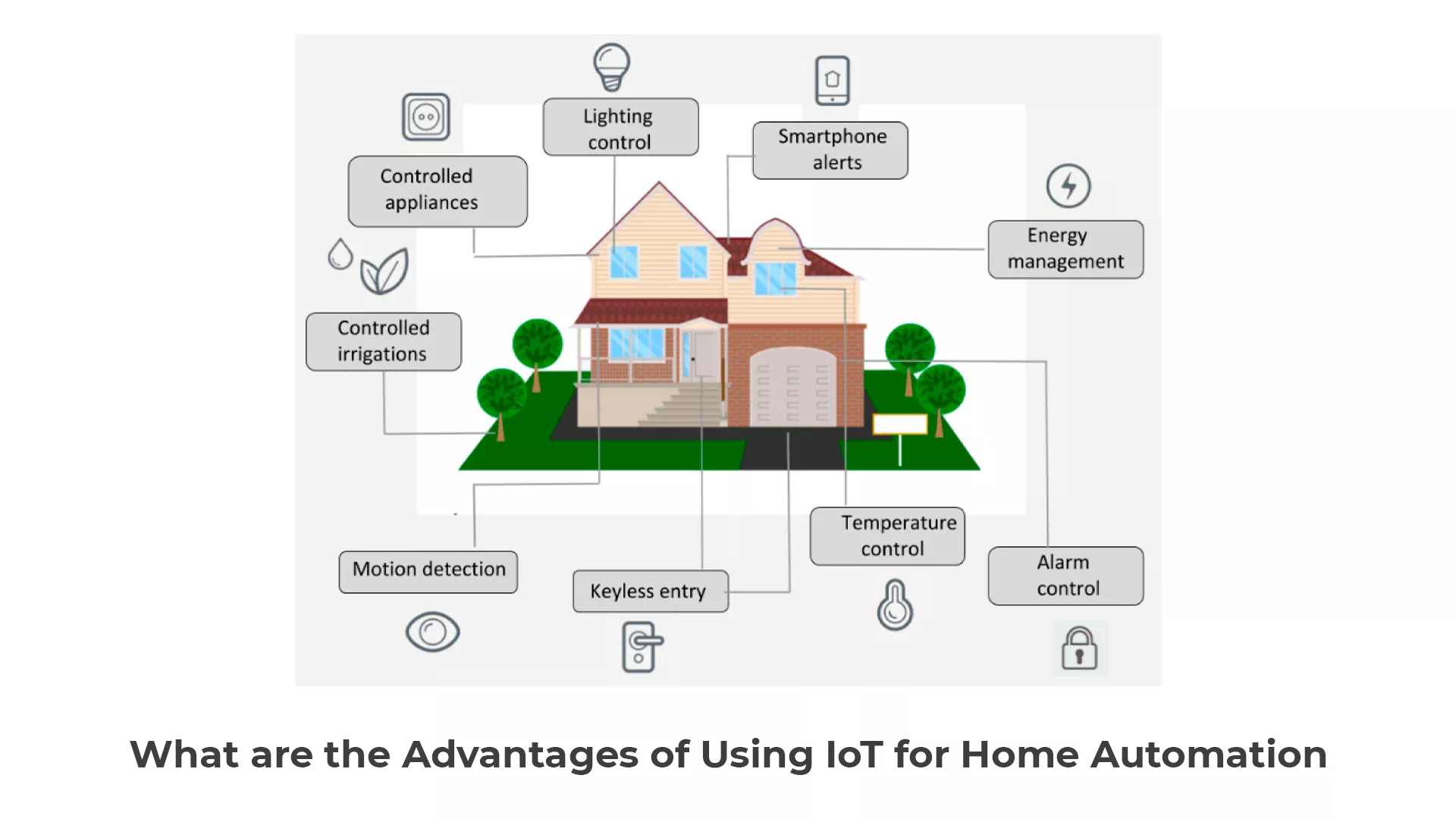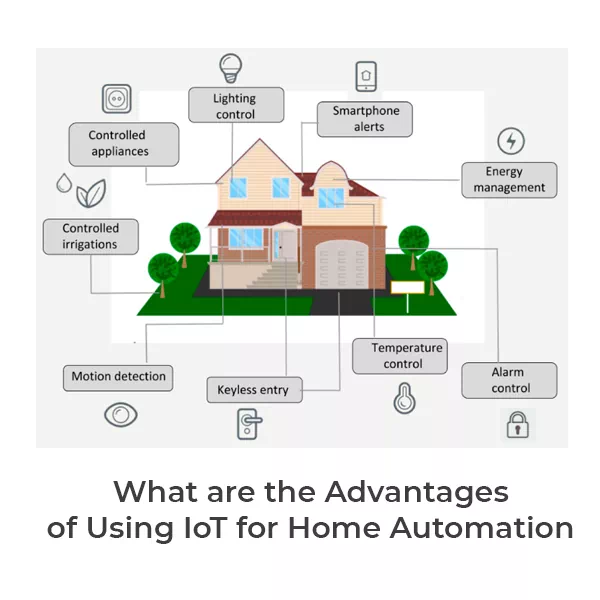IoT or the Internet of Things is a network of physical objects that are embedded with sensors, software, and connectivity to exchange data with other devices and systems over the internet. IoT can be used in various applications like home automation, healthcare, transportation, agriculture, and more. In home automation, IoT enables homeowners to control their smart devices remotely through smartphones or voice assistants.
One significant advantage of using IoT for home automation is convenience. With IoT-enabled devices at home such as smart thermostats, lighting systems, locks and security cameras; homeowners can have complete control over their homes from anywhere in the world. For instance, one can turn on/off lights in different rooms without being physically present there.
Another benefit of using IoT for home automation is energy efficiency. Smart thermostats that use algorithms to learn user behaviour while adjusting temperature settings accordingly can help reduce energy consumption by up to 15%. Additionally, automatic lighting controls ensure lights are not left on when they are not needed which also reduces electricity bills significantly.
IoT devices provide enhanced security features that ensure the safety of your home and loved ones. Smart locks, cameras, motion sensors, and alarms can be integrated to create a comprehensive security system that alerts you in case of any suspicious activity or danger. In addition to providing peace of mind, this feature can also deter potential intruders from targeting your home.
Benefits of Home Automation
Home automation is the future of home management. With IoT devices becoming more affordable and accessible, homeowners can now remotely control their homes' temperature, lighting, security systems and even kitchen appliances. One of the most significant benefits of using IoT for home automation is convenience. Homeowners no longer have to worry about leaving their lights or heater on when they leave the house or manually locking all doors before going to bed as these tasks can be automated.
Home automation also helps in energy conservation by reducing unnecessary usage of electricity which lowers monthly bills. Smart thermostats help achieve this by learning your habits and preferences over time, optimizing temperature settings based on occupancy patterns without compromising comfort levels. This feature not only reduces energy consumption but also saves money.
Cost Savings
One of the biggest advantages of using IoT for home automation is cost savings. By automating various tasks and devices in your home, you can save money on energy bills and reduce wastage. For example, smart thermostats can learn your behaviour patterns and adjust the temperature accordingly, leading to reduced energy usage and lower electricity bills.
Another way IoT can help with cost savings is through predictive maintenance. With smart sensors installed in your devices, you can be alerted when something needs fixing or replacing before it breaks down completely. This will prevent costly repairs or replacements in the future.
Increased Security
Increased security is one of the significant advantages of using IoT for home automation. With the integration of smart devices, homeowners can remotely monitor their homes from anywhere using their smartphones or tablets. Smart locks, motion sensors, and cameras are some of the smart home devices that can enhance the security of a home. For instance, with a smart lock installed in your front door, you can lock and unlock it remotely via an OOB Smart Home app.
Moreover, motion sensors alert homeowners when there is movement within their properties. They send notifications to mobile phones or emails prompting users to take necessary actions. Additionally, surveillance cameras provide live feeds and recordings which homeowners can access on-demand giving them full control over their property's security.
Energy Efficiency
One of the most significant advantages of using IoT for home automation is energy efficiency. With IoT-enabled devices, homeowners can monitor and control their energy consumption in real-time, allowing them to make more informed decisions about their usage habits. For instance, smart thermostats can learn a homeowner's schedule and automatically adjust the temperature based on when they're at home or away, resulting in significant savings on heating and cooling costs.
Another benefit of IoT for energy efficiency is the ability to integrate renewable energy sources into a home's power grid. Smart solar panels that are connected to an IoT platform can track the amount of sunlight received throughout the day and adjust their output accordingly. This means homeowners can maximize their use of clean, renewable energy while minimizing their reliance on traditional power sources.
Improved Comfort & Convenience
One of the primary advantages of using IoT for home automation is improved comfort and convenience. With smart devices and sensors, homeowners can easily control various aspects of their homes such as lighting, temperature, and security with just a few taps on their phones. This means that they no longer have to manually adjust thermostats or turn off lights in different parts of the house.
IoT devices also allow for personalized settings and preferences, providing more comfort to homeowners. For example, smart thermostats can learn an individual's schedule and adjust temperatures accordingly to provide optimal comfort throughout the day. Smart lighting systems can also be programmed to mimic natural light patterns, helping homeowners maintain their circadian rhythm.
Integrating with Other Technologies
Integrating IoT technology into home automation systems has significant advantages. By using various sensors, cameras, and smart devices, homeowners can monitor their homes remotely and automate various tasks such as turning off lights or adjusting the thermostat. Since most IoT devices are designed to be compatible with each other, integrating them is seamless and easy.
Furthermore, integrating IoT technology with other technologies like artificial intelligence (AI) can provide even more benefits. For instance, AI-powered voice assistants like Amazon’s Alexa or Google Assistant can process complex commands from homeowners to automate multiple tasks simultaneously. With this level of automation in place, homeowners can save time and energy while still ensuring that their homes are running efficiently.
To summarize, integrating IoT technology with other technologies provides numerous benefits for home automation systems. Homeowners can enjoy a more comfortable living space while enjoying the convenience of remote monitoring and automation through voice-activated controls. Additionally, by relying on intelligent technology that uses machine learning algorithms to optimize energy consumption patterns based on user behaviour data analysis allows users to save on energy bills over time too!
Conclusion:
In conclusion, the advantages of using IoT for home automation are numerous. First and foremost, it provides convenience and flexibility to homeowners. With IoT-enabled devices, one can remotely control various aspects of their homes such as lighting, heating and cooling systems, security cameras and more. This means that you don't have to be physically present at home to make changes or monitor activity.


